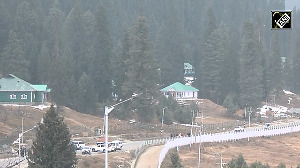Prabhadevi, in central Mumbai, accommodates residential high-rises, old cottages, a liberal sprinkling of offices and the Siddhivinayak temple.
But in the past five years, it's not just devotees of Ganesha who have been flocking to Prabhadevi. A range of car makers, from Mercedes to Tata, Hyundai, Skoda and recently Ford, have been rushing here to set up showrooms on the main street.
They may not have been seeking blessings, but the past few years for these car dealers have been nothing short of prayers answered.
From 1999 to 2004, sales of mid-segment cars in the price band of Rs 460,000 to Rs 800,000 have nearly trebled, from 65,000-odd units in 1999 to 172,000 units in 2004 (source: Society of Indian Automobile Manufacturers.
| THE PRICE IS RIGHT | |||
| Car |
2001 |
2004 |
% change |
| IKON | 6.28 | 5.57 | -11.31 |
| CITY | 8.2 | 7.05 | -14.02 |
| ESTEEM | 5.66 | 4.92 | -13.07 |
| CORSA | 6.49 | 5.47 | -15.72 |
| BALENO | 8.11 | 5.97 | -26.39 |
| LANCER | 9.3 | 8.85 | -4.84 |
| AMBASSADOR | 4.12 | 4.24 | 2.91 |
| PETRA/SIENA | 7.22 | 5.46 | -24.38 |
| Ex-showroom prices in Delhi Figures in Rs lakh | |||
However, it's not that the entire mid-segment is growing -- only six (Ikon, City, Esteem, Indigo, Baleno and Optra) of the 11 models in the category delivered their "car"eer-best records in 2004.
Priced catch
Industry analysts attribute the consistent increase in sales to both dropping prices and rising aspirations. For instance, from 2001 to 2004, prices fell by an average 14 per cent in the C-segment.
An industry expert points out that all the C-segment models barring the Indigo, the new City and the Optra have been in the Indian market for more than five years.
As a result, the share of local components under the bonnet increased and car makers were able to bring down the prices.
The Ikon from Ford is a case in point. Ford India started sourcing engines for the Ford Ikon from Hindustan Motors in 2003 (previously engines were imported from South Africa).
As a result local content in the Ikon went up from 70 to 90 per cent. Naturally then, Ford could afford to make its prices more attractive.
That certainly helped sales. Until 2002 sales had been steadily sliding: from 17,400-odd units in 2000, Ikon sales had dropped to 14,970 units in 2002.
But once Ford introduced the Ikon Flair with its Indian 1.3 Rocam engine in August 2003, sales started climbing. The result: last year Ikon sold 24,536 units -- its best on Indian roads since its launch in 1999.
Even Maruti's Baleno (which is in the upper C segment) has piggybacked on the price proposition to widen its customer base. Between 2001 and 2004, Baleno's prices dropped by an average 26 per cent. The effect on the sales graph has been equally dramatic -- from 1,347 units in 2001, last year Maruti rung up sales of 6,521 Balenos.
Perhaps the only player who turned in a less-than-satisfactory progress sheet was Hyundai Accent. It, too, played the price game in December 2003, when it lowered the price of the Accent base model by nearly 15 per cent to bring it just under the critical Rs 500,000 barrier.
But shopfloor glitches hit production between April and June 2004. Consequently, for the first time since its launch in 1999, the Accent has seen a drop in sales. Mind the gap
There's more to the price angle. Even as prices in the C segment fell, prices in the B segment were increasing with the new entry of new players. That meant the price differential between the B and C segments was narrowing.
Until the launch of the Tata Indigo in December 2002, the only mid-size car to be sold at under Rs 450,000 was Hindustan Motors' Ambassador. And B-segment offerings like the Fiat Palio, followed by the Corsa Sail and more recently, the Hyundai Getz are in the Rs 350,000 to Rs 500,000 range. So it's no longer such a huge leap for customers to migrate from the B- to the C-segment.
As Vijay Chandorikar, a Mumbai-based auto industry consultant, points out, "Since the new B-segment models are polarised at the top end, first-time buyers are considering the lower-end sedans as an option to a B+ model."
The price differential gets further reduced when consumers opt for auto finance schemes.
| Car FinanC Auto industry observers cite car loans as the biggest driving factor for the expansion of the C-segment. At present, almost 85 per cent of all new car sales are backed by auto finance, compared to 65 per cent five years ago. Dealers point out that 80 per cent of the C-segment sedan buyers opt for auto finance schemes. And HDFC Bank estimates the car loan industry has been growing at 25 per cent over the past three years. You don't have to look far to understand why. Interest rates on car loans have come down drastically in the past four or five years, which helps prospective buyers take the plunge. Explains Rajive Saharia, deputy general manager, marketing, Honda Siel Cars India, "The growth of the C-segment in the past few years can be mainly credited to factors such as rise in income levels leading to increased affordability an d simultaneous reduction in interest rates leading to lower EMIs." But not everybody believes the drop in rates has persuaded more people to opt for costlier cars. Says Sachin Khandelwal, head, vehicle finance, ICICI Bank, "The drop in interest rates usually helps very few people to probably shift from the base model to a deluxe model. A larger shift happens if people are willing to take long-term loans, like five years instead of the earlier three-year loans." Perhaps that's one reason why car loan companies are offering high tenures (of up to 84 months), after an upward rate revision in December 2004 (interest rates climbed by 100 basis points). Executives at HDFC Bank claim that despite the revision, the demand for loans has not dropped since the higher tenure for loans increases affordability. Helping fuel demand is the higher disposable incomes all around. In fact, most banks claim that over the past five years there's been a dramatic change in the profile of applicants for C-segment car loans. In 2000, applicants were typically middle or senior-level managers; now most of them are young executives and MBAs with less than five years' experience. According to ICICI Bank, the top 15 cities contribute almost 75 per cent of C-segment volumes. Adds Khandelwal, "A good share comes from double-income households, where many of the younger working population are taking four- and five-year loans to buy a car from the C- rather than B-segment." The takeaway: the C-segment accounts for one of every five cars sold in India, but one of every three car loans sanctioned. Those are numbers to watch out for. |
And, say auto dealers, about eight out of every 10 people get their car purchases financed. Car makers agree.
Says Rajiv Dube, vice president, commercial, passenger car business unit, Tata Motors, "More and more car purchases are being determined by monthly instalments."
In the past four or five years, interest rates on car loans have plummeted from 17 per cent to around 9 per cent. That makes even a hefty loan more easily repayable.
Rishabh Sheth, a Ford dealer in central Mumbai, points out that the difference in the monthly instalment for a five-year loan on the base model of the Ford Ikon (about Rs 500,000) and a Santro (Rs 400,000) is just Rs 1,000-2,000. "Customers do not mind that difference," he adds.
Ease of repayment has also helped lure in a younger customer base for the C-segment. Sachin Khandelwal, head, vehicle finance, ICICI Bank, points out that the average age of a C-segment car owner has come down from 35 years in 2000 to 31 years in 2004. An executive at HDFC Bank concurs.
"Going by recent trends, a C-segment car has also become an entry-level car. This is the result of the drop in the age of the car owner and rising aspirational levels," he says.
New sense
The increase in popularity of sedans is also directly proportional to the new launches in the category. Among the six models that have peaked in sales since 1999, three of them -- Honda City, Tata Indigo and Chevrolet Optra -- were entirely new introductions.
Says Dube, "The growth of the C-segment is primarily because of the Tata Indigo and the Honda City driving volumes at the lower and upper points."
When The Strategist looked at the most successful relaunches over the past two years, the Honda City was rated among the top relaunches. But it wasn't really a relaunch; the new City was just that -- a new car.
| THE C-SEGMENT PICKS UP SPEED TOTAL SALES | ||||||
| MODEL | 1999 | 2000 | 2001 | 2002 | 2003 | 2004 |
| Accent | 1,689 | 16,205 | 16,267 | 20,003 | 25,002 | 24,383 |
| Ikon | 1,677 | 17,402 | 15,218 | 14,970 | 18,565 | 24,536 |
| City | 9,167 | 10,555 | 9,223 | 11,840 | 14,355 | 30,786 |
| Esteem | 16,451 | 12,268 | 11,809 | 11,204 | 11,117 | 18,379 |
| Indigo | 0 | 0 | 0 | 466 | 25,952 | 36,251 |
| Lancer | 7,621 | 7,991 | 6,438 | 5,935 | 2,961 | 2,509 |
| Corsa/Wagon | 0 | 4,069 | 5,805 | 7,109 | 6,829 | 5,680 |
| Baleno | 352 | 4,142 | 1,347 | 648 | 1,816 | 6,521 |
| Optra | 0 | 0 | 0 | 0 | 4,247 | 9,191 |
| Ambassador | 16,368 | 18,805 | 14,382 | 13,768 | 11,693 | 12,740 |
| Petra/Siena/Weekend | 3,642 | 2,471 | 1,042 | 2,746 | 914 | 1,157 |
| Others | 8,731 | 5,035 | 2,268 | 1,440 | 643 | 0 |
| Total | 65,698 | 98,943 | 83,799 | 90,129 | 124,094 | 172,133 |
But Honda wanted to cash in on the equity of the City brand -- when it was phased out, the old City was selling over 900 cars a month. And the reason for introducing a smaller, less powerful version was not because the older City was no longer made in other markets around the globe. In fact, Honda wanted to raise volumes.
As Saharia told The Strategist earlier, "To get bigger numbers, we had to look at an all-new car." The gambit worked: 30,786 new Honda Citys hit the road in 2004, compared to the 14,355 sold in 2003.
The Tata Indigo, a sedan version of the Indica, got off the mark in December 2002. In just two years, the Indigo has become the leader of the category, clocking sales of over 2,000 units every month on the back of its strong presence in the diesel segment.
Industry observers say that the Indigo lords over 98 per cent of diesel car sales in the lower end of the mid segment, because the car has little competition at that price point (Maruti Esteem's primary focus is on the petrol variant).
Still, the Esteem has been the dark horse in the C-segment race. Riding on the back of a superficial new look along with a Rs 50,000 price cut in mid-2004, the Esteem touched sales of 18,379 units in 2004, which is even better than the 16,415 cars it sold in 1999 when it was the market leader. Price cuts would have ensured that a new set of buyers rush into the C- segment.
But with the C-segment accounting for just around 20 per cent of new car sales, India is still far behind other developing markets (60 per cent of cars sold in India are still small cars, from the A- and B-segments). Tata Motors' Dube points out that the mid segment accounts for 35 per cent of total car sales in other developing markets.
When that happens in India, even the gods will be smiling.
| HORSE AND CARRIAGE If cars are zooming out of showrooms, are car dealers getting richer? No, say most dealers. And auto industry consultant, Vijay Chandorikar seconds them. According to him, car dealer margins in other markets are in the range of 7 or 8 per cent. But in India it is just 2 per cent. This means that for every car that sells for Rs 5 lakh, the dealer makes just Rs 10,000. Factor in costs like storage, showroom maintenance, salaries and other overheads and you wonder whether the dealers earn enough to make a living. So where does the money come from? In a word: accessories. Read the fine print on any car ad. "Accessories shown are not a part of the standard equipment" it proclaims sternly. This is where the dealers step in. Consultants say that any car owner would spend at least Rs 15,000 or Rs 20,000 on standard accessories such as door mats, burglar alarms and so on in a city like Mumbai. When you consider that the base models of most cars don't come with factory-fitted audio systems, expect that figure to go up by half, especially in north India. (The amount is likely to be far lower down south where car accessories aren't considered indispensable.) Also, dealers are the first point of contact for vehicle insurance agents and, of course, car loans. Is it a mere co-incidence that 85 per cent of cars bought in the country are backed by auto loans? |






